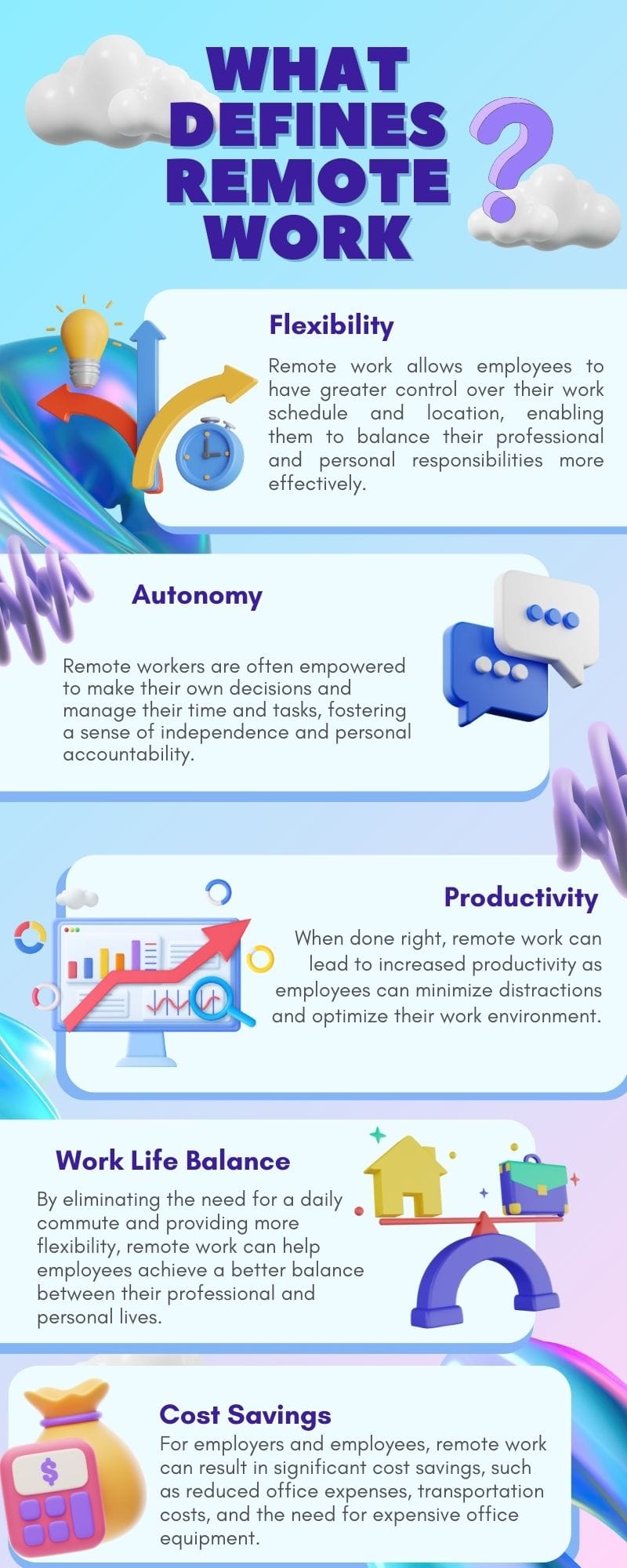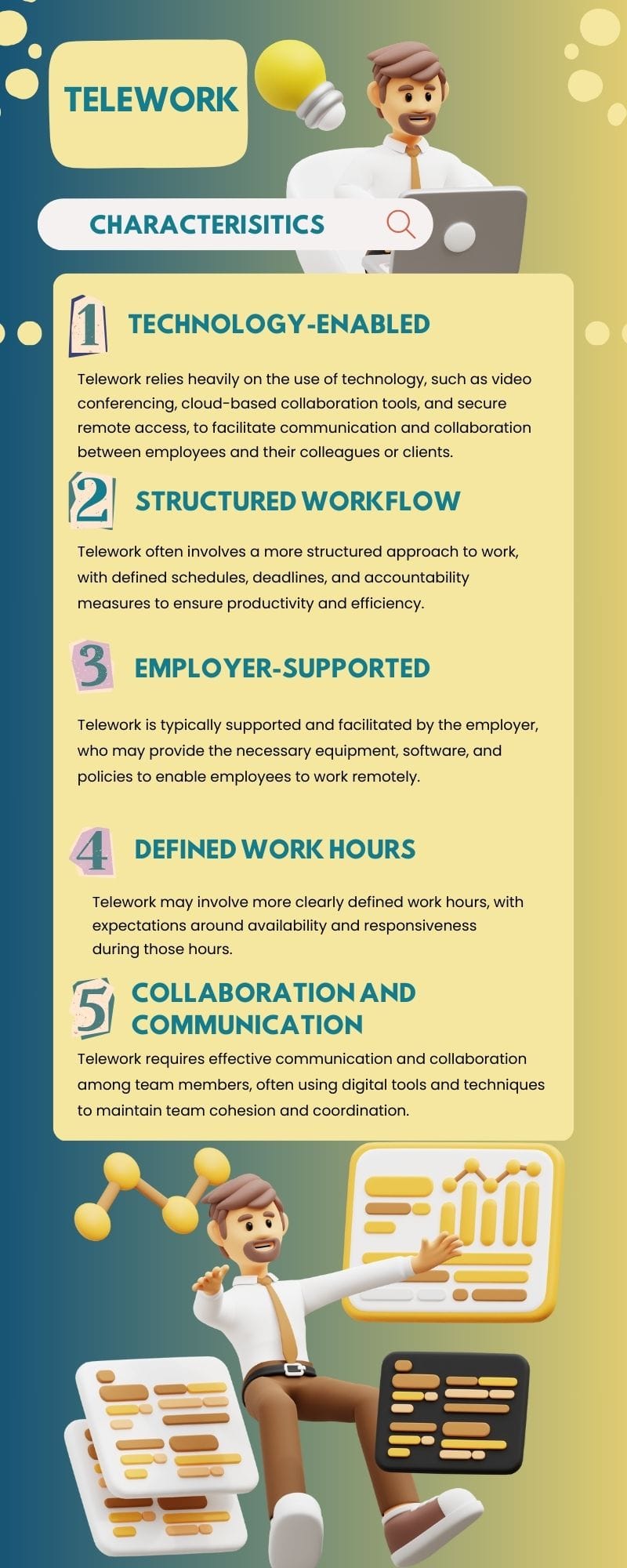Remote Work vs Telework — Key Differences and Benefits
Confused about telework vs remote work? Get clear definitions, explore the key differences to help you decide which work style is best for you, and learn the proven strategies for the best results.

Whether you call it telecommuting, remote work, or working from home (WFH), the core idea is the same: completing your job duties outside of a traditional office setting.
This practice has been revolutionizing the way we think about employment since the 1970s.
The Rise📈 of Distributed Work💻
- 1973: Jack Nilles 👨💼 coins "telecommuting" during the US ⚡ energy crisis, sparking interest in alternative work arrangements.
- 1990s: The US 🇺🇸 passes the Telecommuting Enhancement Act, encouraging federal agencies to allow telecommuting 🏠
- 2005: With increased 🌐 broadband access, "remote work" becomes a mainstream term 🎉
- 2010s: The rise of 🛋️coworking spaces provides infrastructure and community for remote workers.
- 2020: COVID-19 🦠 pandemic forces a global shift to remote work, proving its large-scale viability 💪.
This flexible approach includes:
- working from home
- coworking spaces
- any place equipped with internet access
- the essential tools needed for the job.
However, understanding the nuances and differences between telework and remote work can be crucial as organizations adopt flexible work arrangements.
Remote Work Definition
Completing your job duties from a non-designated location outside a traditional office setting, with flexibility regarding specific location (home, co-working space, etc.).

Why Remote Work is Winning Over Employees
- Remote work offers employees unparalleled control over their schedules and work locations, empowering them to strike a balance between professional and personal responsibilities.
- Remote work environments foster a sense of independence, as employees can make their own decisions and manage their time and tasks. This autonomy enhances personal accountability and job satisfaction.
- When implemented effectively, remote work can boost productivity. Employees have the opportunity to minimize distractions and create an optimal work environment tailored to their needs.
- No daily commute and the added flexibility that remote work provides are key factors in helping employees achieve a healthier balance between their work and personal lives.
- Remote work can lead to substantial cost savings for both employers and employees. Reduced office expenses, lower transportation costs, and less need for pricey office equipment are just a few of the financial benefits.
Telework Definition
Telework, or teleworking/telecommuting, also empowers employees to fulfill their job responsibilities from locations beyond the traditional office setting.
Yet, it implies completing duties from a designated home office environment, and using technology to communicate and collaborate with colleagues.

It can be a home, a satellite office, or a coworking space, – telework utilizes cutting-edge technology to 'disregard' location and streamline collaboration.
- Telework thrives on advanced technology, including video conferencing, cloud-based collaboration tools, and secure remote access, ensuring seamless interaction and teamwork.
- It assumes a more structured work approach, featuring clear schedules, deadlines, and accountability measures to boost productivity and efficiency.
- Employers play a pivotal role in facilitating telework by providing essential equipment, software, and policies that empower employees to work remotely.
- Telework often comes with clearly outlined work hours, setting expectations for availability and responsiveness during these times.
- Effective telework hinges on robust communication and collaboration among team members, leveraging digital tools to maintain team cohesion and coordination.
Differences between Telework and Remote Work
Think of remote work as completely severing ties with the traditional office environment, while telework is like having one foot out the door.
- Remote Work: Completely severed ties. Remote workers can be located anywhere they have a reliable internet connection. They could be working from a beach in Bali, a bustling coffee shop in Berlin, or their home in a rural town. Can encompass freelancers, contractors, or those with flexible arrangements with their company.
- Telework: One foot out the door. Often used in government or corporate settings. Teleworkers typically work from a designated alternative workspace, often their home office, but within a commutable distance of the main office. Occasional in-person meetings or check-ins might be required.
Structure and Flexibility📈
- Remote Work: More self-directed. Remote workers have greater control over their work schedules and environments. They might set their own hours and work routines, – the most important is to meet deadlines and deliverables.
- Telework: More structured. Telework arrangements are often pre-defined by the employer, with specific work hours and expectations for online availability. The employer might also require teleworkers to use specific work tools or software.
Employer Involvement and Support👨💼
- Remote Work: Less direct involvement. Employers might provide some remote work resources but generally expect remote workers to be self-sufficient in managing their work environment and tools.
- Telework: More direct involvement. Employers typically provide teleworkers with the necessary equipment, software, and IT support to function effectively outside the office. They might also have specific protocols for communication and collaboration.
Communication and Collaboration📢
- Remote Work: Asynchronous communication might be more common. Remote teams might rely heavily on email, project management tools, and video conferencing for communication and collaboration.
- Telework: Synchronous communication might be emphasized. Teleworkers might be expected to be available during regular business hours for calls, meetings, or instant messaging for real-time collaboration.
Taxes and Legalities⚖️
- Remote Work: Depending on the location and tax laws, there could be tax implications for both the employer and the remote worker, especially when paying independent contractors. It's important to be clear on these details beforehand.
- Telework: Since teleworkers are technically still connected to the main office location, these tax and legal implications are usually less complex.
The ideal work arrangement hinges on three key factors
1️⃣The employer's game plan: Different businesses have different needs. Some require occasional in-person collaboration, while others thrive on a fully distributed workforce.
2️⃣The employee's function: Certain roles benefit more from remote work due to their independence. Others might require access to specialized equipment or in-person interaction.
Remote-Ready and In-Office Roles
Remote-friendly roles typically involve independent work and digital or written deliverables. Examples include software development, writing & editing, customer service via email/chat, social media management, graphic design, translation, and certain admin roles.
On the other hand, roles like management, sales with significant client interaction, manufacturing, logistics, lab techs, and healthcare professionals usually need in-person presence due to relationship building, task delegation, use of physical products, or direct contact with equipment/patients.
3️⃣Individual preferences: Some people flourish in a quiet home office, while others crave the social connection of a physical workplace. Flexibility in choosing what works best is key.
Best remote companies to work for
Below are the top telework-friendly businesses to jumpstart your remote job search. While it is not an exhaustive list, it can be a good starting point for exploring remote work opportunities.

Automattic (WordPress): Known for a strong remote culture, offering flexibility, global work teams, and a focus on results.
GitLab: Champions remote work, provides generous equipment allowances, and fosters a transparent work environment.
Zapier: Offers complete remote work freedom, promotes autonomy, and boasts a culture of open communication.
Dropbox: Embraces a "work from anywhere" policy, encourages work-life balance, and provides a strong benefits package.
HubSpot: Remote-first company with a culture of ownership, strong support system for remote employees, and opportunities for professional development.
Buffer: Pioneered remote work, offers unlimited vacation, and emphasizes a people-centric approach.
InVision: Fully remote, provides a collaborative work environment with a focus on employee well-being.
SurveyMonkey: Encourages remote work with a global workforce, offers competitive salaries, and promotes a culture of trust.
Upwork: The world's largest freelance marketplace, ideal for those seeking project-based work and location independence.
Airbnb: Fully remote for many roles, offers a chance to work for a company that values flexibility and embraces a global mindset.
Proven Strategies for Effective Remote and Telework Management
Clarify Expectations
- Discuss with your employer whether the role is telework or fully remote.
- Gain an understanding of work policies, regulations, instructions, benefits, resources, and available assistance.
- Agree on communication norms, schedules, and productivity metrics to ensure alignment between you and your manager.
Establish a Dedicated Workspace
- Create a professional, distraction-free work environment at home, even for telework situations.
- Invest in the necessary equipment, ergonomic furniture, and reliable internet connection to support your productivity.
Manage Your Time Effectively
- Set clear boundaries between work and personal life, especially for remote work. Apply a time tracker for accurate work time calculations.

- Develop a routine and stick to a schedule to maintain a work-life balance.
- Use productivity tools and techniques to stay focused and on track.
Communicate Proactively
- Check in regularly with your manager and team, even for informal updates.
- Ensure you are available and responsive during agreed-upon work hours.
- Participate actively in team meetings and collaborative activities.
Prioritize Self-Care
- Take breaks, exercise, and engage in activities that help you recharge.
- Maintain social connections with colleagues and personal networks.
- Seek support and resources to address any mental health or well-being concerns.
Must Have Remote and Telework Management Tools
Communication and Collaboration Tools
- Video conferencing: Zoom, Microsoft Teams, Google Meet
- Instant messaging: Slack, Microsoft Teams, Google Chat
- Project management and task tracking: Trello, Asana, JIRA
- Cloud-based document sharing and collaboration: Google Workspace, Microsoft 365

Productivity and Time Management Tools
- Task and to-do list managers: Todoist, Microsoft To-Do, Notion
- Time tracking and Pomodoro apps: TMetric, Pomodoro timers
- Note-taking and organization tools: Evernote, Notion, OneNote
- Calendar and scheduling apps: Google Calendar, Microsoft Outlook
Virtual private network (VPN) software
- Password managers: LastPass, 1Password, Bitwarden
- Two-factor authentication apps: Google Authenticator, Authy
- Secure file transfer and cloud storage: OneDrive, Dropbox, Google Drive
What are cybersecurity best practices for remote workers to protect company data?
Cybersecurity is a critical concern for organizations of all sizes, and protecting sensitive company data becomes even more challenging when employees work remotely.
Here are some best practices that remote workers can follow to help keep their devices and the company's data secure.
- Use strong, unique passwords: Remote workers should use a password manager to generate and store strong passwords securely with complex and unique passwords for each account they access.
- Enable multi-factor authentication (MFA): MFA adds an extra layer of security by requiring users to provide two or more verification factors to access an account.
- Keep software up-to-date: Regularly update your operating system, web browser, antivirus software, and other applications to ensure that you have the latest security patches installed.
- Use a virtual private network (VPN): A VPN encrypts internet traffic between your device and the VPN server, making it difficult for hackers to intercept or eavesdrop on your communication.
- Be wary of phishing emails: Phishing attacks often target remote workers who may be distracted or working in unfamiliar environments. Always double-check email addresses and links before clicking on them, and never share sensitive information via email unless you are certain it is legitimate.
- Secure home networks: Ensure that your wireless router is configured with WPA3 encryption and has a strong administrative password.
- Avoid public Wi-Fi networks: Public Wi-Fi networks are notoriously insecure, so avoid using them whenever possible.
- Backup important files: Make sure to regularly backup important files to a cloud storage service or external hard drive to prevent data loss.
- Limit access to sensitive data: Implement role-based access control to limit access based on user roles and responsibilities.
- Follow company policies: Adhere to your organization's security policies and procedures around password management, acceptable use of equipment, and incident response protocols.
Equipment and Hardware
- Laptop or desktop computer
- Reliable high-speed internet connection
- Webcam and headset for virtual meetings
- Ergonomic desk and chair setup
- Printer, scanner, and other necessary peripherals
Wellness and Self-Care Tools

- Meditation and mindfulness apps: Calm, Headspace
- Exercise and fitness apps: Nike Training Club, iFit, NordicTrack
- Mental health and well-being resources: Online counseling, Employee assistance programs
✅Track time accurately and boost productivity from anywhere with TMetric, the must-have tool for effective remote work management


